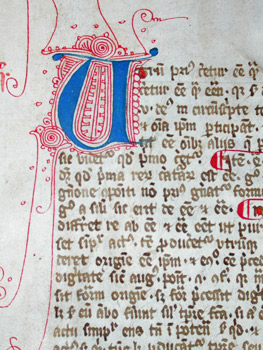Two Red Letter Books August 14, 2012
Author: Beach Combing | in : Medieval, Modern , trackbackHere is a little historical puzzle: This account comes from northern Scotland.
The least dilapidated of the chapels was dedicated to St Regulus, and there is a tradition that at the Reformation, a valuable historical record belonging to it, the work probably of some literary monk or hermit, was carried away to France by the priest. I remember a very old woman, who used to relate that when a little girl, she chanced, when playing one day among the ruins with a boy a few years older than herself, to discover a small square recess in the wall, in which there was a book; she had only time to remark that the volume was a tattered one, and apparently very old, and that there were beautiful red letters in it, when the boy, laying claim to it, forced it from her. What became of it afterwards she did not know, and, unconscious of the interest which might have attached to it, never thought of making inquiries.
There is nothing incredible about this story. In northern Europe generally, but particularly in the Gaelic world, books were hidden in walls: and sometimes have been recovered from the same. The red initialing might well appear in a manuscript of the right age. However, compare now this story with one from Ulster, over in Ireland, described by a certain K sworn to by the girl in question and one of the most respectable men in the village.
When I was a lump of a girl, I was sent to school for longer than any of the neighbours’ childer. My father was set on giving us all the teachin’ he could, and we had a right master at the time in Kilmore, far before any of the, ‘nationals’ that’s goin’ at present; troth he had wit enough for a college, and nothing cum wrong to him. I was playin’, away a good piece from the school one Saturday, whin we got lave early, among the ould walls of an ancient building in the grave-yard, that was there before the ouldest in the town was born, and I spies a book lyin’ on the sill of the place where there had been a window at one time. I lifted the book, proud enough at findin’ it, and consaited at the notion of shewin’ it to the scholars, but I darn’t take it home for fear of getting’ a cuttin’ from my mother for liftin’ what didn’t belong to me. I took it to Glenariff the next day, and show’d it to two or three knowledgeable men comm’ home from chapel, but they could make nothing of it. The letters was red, and a different shape from ours, and there was like bits of gold on the outside. I kep’ it hid for a time, and then gev it to the master, tellin’ him all about it. It bate him, as well as the rest; he studied to make it out, but he could make neither top nor tail of it. ‘It’s in a forrin tongue, Peggy,’ says he, ‘and you’d best lave it where you got it.’ I had no courage to go back by myself, and a boy in the school went with me to the walls, and I put it down in its own place, trimlin’ with fear, The boy and me went a piece off to watch if any body would lift it: we watched on till it was near dark, and when we looked if it was there, it was away.
K, the author, knew of the earlier account and was worried by it. The story had been told by him as a memory and yet the two were just too similar. The earlier account suggests, in fact, that it was actually a folk story of some kind: or are we to imagine similar circumstances down to the red letters? Drbeachcombing AT yahoo DOT com
***
‘Beach you’ve been naughty’, writes Southern Man 31 Dec 2016, ‘the second episode in K is a banshee story and you did not tell us! There is no question that the book needs to be seen in this light as a fariy possession tale. that’s all the explanation you need.’



